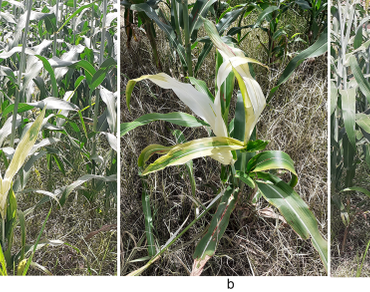Natural infection of Ca. Phytoplasma sacchari causing sugarcane grassy shoot disease in Sorghum bicolor
Nithya K., Vardhan J. Vishnu, Balasaravanan S., Kaverinathan K., Viswanathan R.
Research Articles | Published: 23 January, 2023
Online ISSN : 2229-4473.
Website:www.vegetosindia.org
Pub Email: contact@vegetosindia.org
First Page: 94
Last Page: 98
Views: 913
Keywords:
SCGS phytoplasma, n S. bicolorn
Abstract
Sugarcane grassy shoot is an important disease in sugarcane affecting the crop in all stages of growth right from germination to the maturity phase. The disease causing pathogen Ca. Phytoplasma sacchari primarily spread from one field to another through infected setts and secondarily from one plant to another through phloem sap feeding leaf hopper insects such as Deltocephalus vulgaris, Cofana unimaculata, Exitianus indicus, and Maiestas portico. Recently, a natural infection of ScYLV was reported in Sorghum almum (Columbus grass) and S. bicolor (grain sorghum) in Florida, USA. Since sugarcane and sorghum have high genetic proximity, we have suspected sorghum and maize crops grown nearby sugarcane areas as a potential reservoir for sugarcane viruses and phytoplasma. Sorghum cultivars showing typical chlorotic spindle leaves with severe stunting were randomly collected in sorghum fields in Coimbatore District during the year 2020 revealed the presence of SCGS phytoplasma through nested-PCR assays and by sequencing of the highly conserved 16SrRNA regions of the genome. The pairwise multiple sequence alignments of SCGS sequences from S. bicolor of this study has clearly shown the highest nucleotide similarities of 99 to 100% with other SCGS sequences from India, SCWL phytoplasma from China, and Sri Lanka.

(*Only SPR Members can get full access. Click Here to Apply and get access)
References
Bouallegue M, Mezghani-Khemakhem M, Makni H, Makni M (2014) First report of sugarcane yellow leaf virus infecting barley in Tunisia. Plant Dis 98:1016. https://doi.org/10.1094/PDIS-12-13-1269-PDN
Delgado HE, Kaye C, Hincapie M, Boukari W, Wei C, Fernandez J, Mollo DS, Comstock J, Rott P (2015) First report of sugarcane yellow leaf virus infecting Columbus grass (Sorghum almum) in Florida. Plant Dis 100:1027. https://doi.org/10.1094/PDIS-10-15-1158-PDN
Deng S, Hiruki C (1991) Amplification of 16S rRNA genes from culturable and non culturable mollicutes. J Microbiol Methods 14:53–61
Doyle JJ, Doyle JL (1990) Isolation of plant DNA from fresh tissue. Focus 12:13–15
Elsayed AI, Boulila M, Odero DC, Komor E (2018) Phylogenetic and recombination analysis of sorghum isolates of sugarcane yellow leaf virus. Plant Pathol 67:221–232. https://doi.org/10.1111/ppa.12708
Gundersen DE, Lee IM (1996) Ultrasensitive detection of phytoplasmas by nested-PCR assays using two universal primer pairs. Phytopathol Mediterr 35:144–151
Jung HY, Sawayanagi T, Wongkaew P, Kakizawa S, Nishigawa H, Wei W, Oshima K, Miyata SI, Ugaki M, Hibi T, Namba S (2003) “Candidatus Phytoplasma oryzae”, a novel phytoplasma taxon associated with rice yellow dwarf disease. Int. J Syst Evol Microbiol 53:1925–1929. https://doi.org/10.1099/ijs.0.02531-0
Kirdat K, Tiwarekar B, Thorat V, Sathe S, Shouche Y, Yadav A (2021) ‘Candidatus Phytoplasma sacchari’, a novel taxon-associated with sugarcane Grassy shoot (SCGS) disease. Int J Syst Evol Microbiol 71(1):004591. https://doi.org/10.1099/ijsem.0.004591
Lee IM, Gundersen DE, Davis RE, Bartoszyk I (1998) Revised classification scheme of phytoplasmas based on RFLP analysis of 16S rRNA and ribosomal protein gene sequences. Int J Syst Evol Microbiol 48:1153–1169. https://doi.org/10.1099/00207713-48-4-1153
Nithya K, Parameswari B, Bertaccini A, Rao GP, Viswanathan R (2020a) Grassy shoot: the destructive disease of sugarcane. Phytopathogenic Mollicutes 10(1):10–24. DOI:https://doi.org/10.5958/2249-4677.2020.00002.X
Nithya K, Parameswari B, Viswanathan R (2020b) Mixed infection of sugarcane yellow leaf virus and Grassy shoot Phytoplasma in yellow leaf affected indian sugarcane cultivars. Plant Pathol J 36(4):364–377. https://doi.org/10.5423/PPJ.OA.06.2020.0092
Rao GP, Prakasha TL, Priya M, Thorat V, Kumar M, Baranwal VK, Mishra AN, Yadav A (2017) First report of association of Candidatus phytoplasma cynodontis (16SrXI-B group) with streak, yellowing, and stunting disease in durum and bread wheat genotypes from Central India. Plant Dis 101(7):1314. https://doi.org/10.1094/PDIS-02-17-0163-PDN
Safarova D, Zemanek T, Valova P, Navratil M (2016) ‘Candidatus Phytoplasma cirsii’, a novel taxon from creeping thistle [Cirsium arvense (L.) Scop.] Int J Syst Evol Microbiol 66 (4): 1745–1753. https://doi.org/10.1099/ijsem.0.000937
Schenck S, Lehrer AT (2000) Factors affecting the transmission and spread of sugarcane yellow leaf virus. Plant Dis 84:1085–1088. https://doi.org/10.1094/PDIS.2000.84.10.1085
Singh BU, Padmaja PG, Seetharama N (2004) Biology and management of the sugarcane aphid, Melanaphis sacchari (Zehntner) (Homoptera: Aphididae), in sorghum: a review. Crop Protect 23:739–755. https://doi.org/10.1016/j.cropro2004.01.004
Srivastava S, Singh V, Gupta PS, Sinha OK, Baitha A (2006) Nested PCR assay for detection of sugarcane grassy shoot phytoplasma in the leafhopper vector Deltocephalus vulgaris: a first report. Plant Pathol 55:25–28
Tiwari AK, Kumar S, Mall S, Jadon V, Rao GP (2017) New efficient natural leafhopper vectors of sugarcane grassy shoot phytoplasma in India. Sugar Tech 19(2):191–197. https://doi.org/10.1007/s12355-016-0455-9
Wang J, Roe B, Macmil S, Yu Q, Murray JE, Tang H, Chen C, Najar F, Wiley G, Bowers J et al (2010) Microcollinearity between autopolyploid sugarcane and diploid sorghum genomes. BMC Genomics 11:261. http://www.biomedcentral.com/1471-2164/11/261
Wei C, Hincapie M, Larsen N, Nuessly G, Rott P (2016) First report of sugarcane yellow leaf virus infecting grain sorghum (Sorghum bicolor) in the United States. Plant Dis 8:1798. https://doi.org/10.1094/PDIS-02-16-0183-PDN
White W, Reagan T, Hall D (2001) Melanaphis sacchari (Homoptera: Aphididae), a sugarcane pest new to Louisiana. Fla Entomol 84:435–436. https://doi.org/10.2307/3496505
Zhang RY, Li WF, Huang YK, Wang XY, Shan HL, Luo ZM, Yin J (2016) Group 16SrXI phytoplasma strains, including subgroup 16SrXI-B and a new subgroup, 16SrXI-D, are associated with sugar cane white leaf. Int J Syst Evol Microbiol 66:487–491. https://doi.org/10.1099/ijsem.0.000712
Acknowledgements
The authors thank the Director, ICAR-Sugarcane Breeding Institute, Coimbatore for providing all the facilities to carry out the work.
Author Information